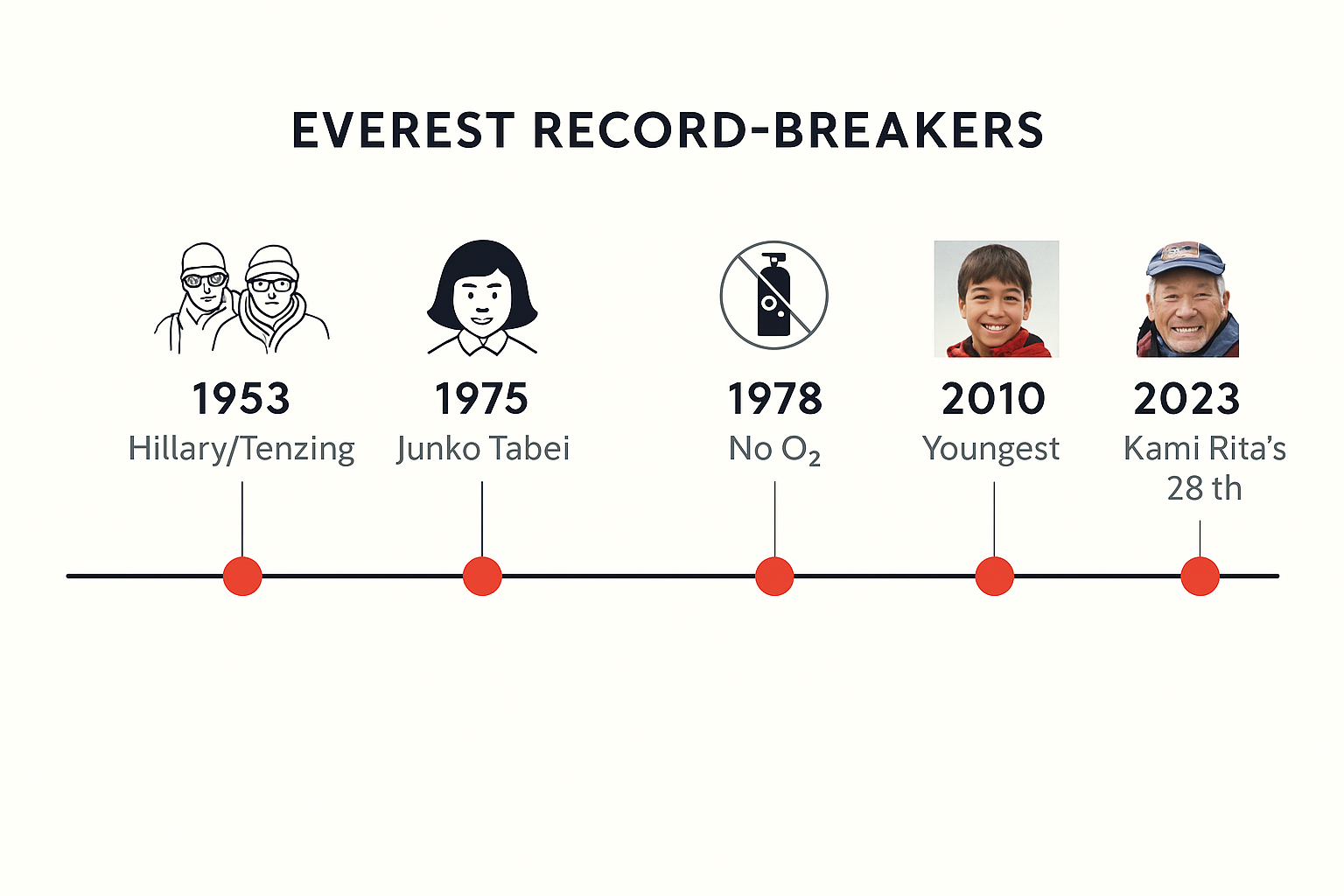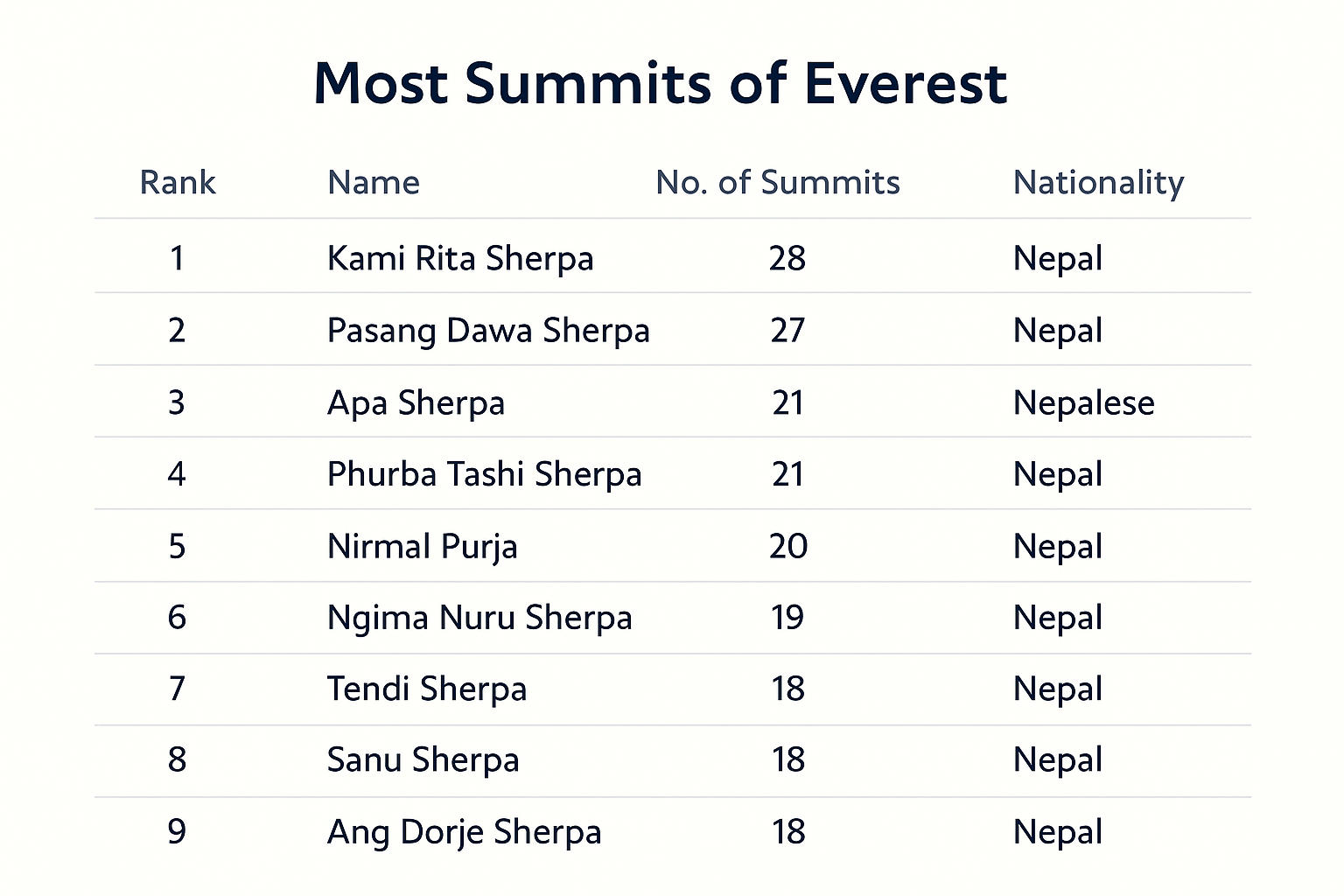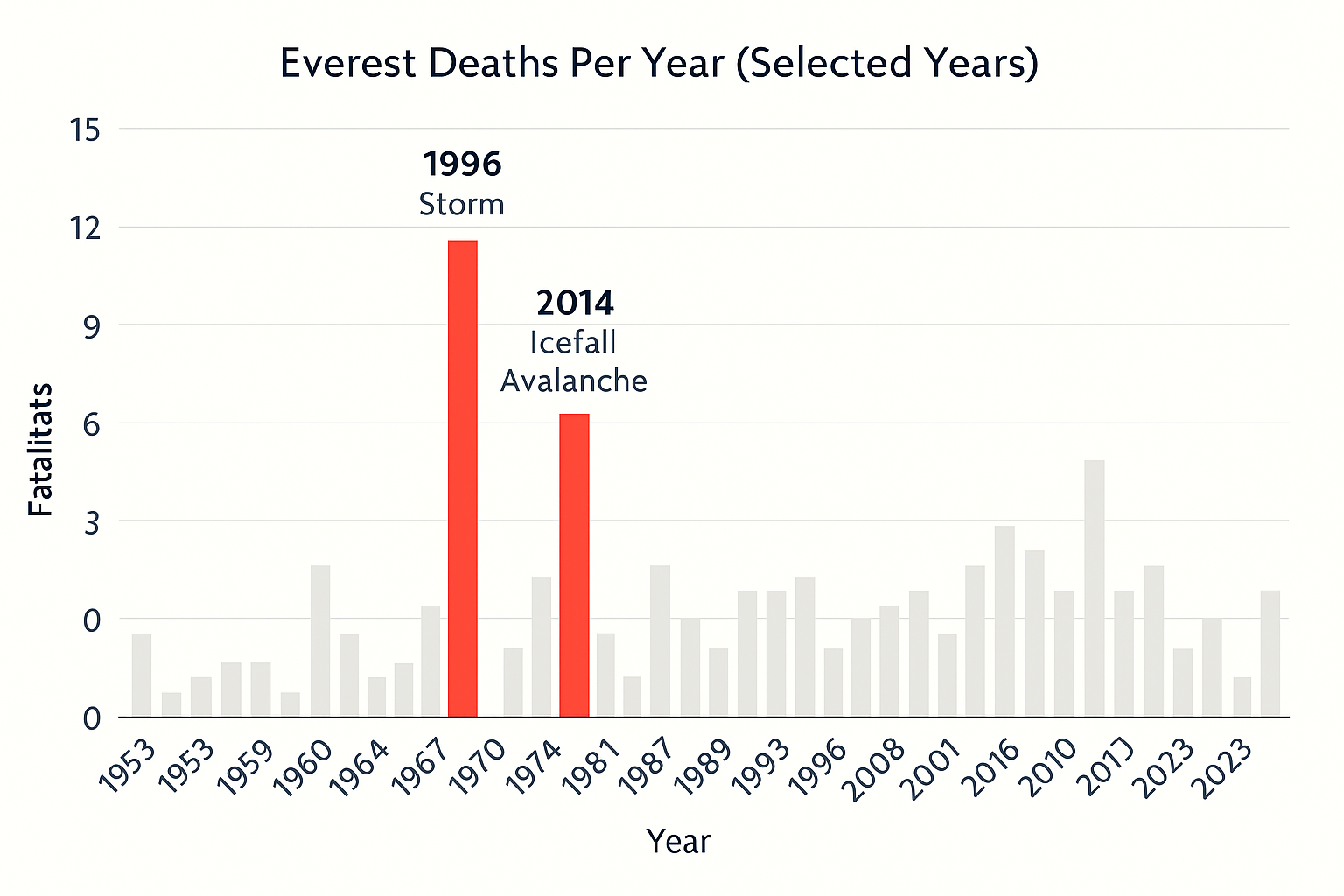Everest Records & Statistics: Summits, Deaths & Superlatives
Mount Everest is a mountain of superlatives, and not just for its height. It is a magnet for record-breakers and a rich source of data that tells a story of human ambition, endurance, and tragedy. The world of Mount Everest records is a fascinating look at how climbers have pushed the limits of possibility for over a century.
This page serves as your data hub for all things Everest. We compile the most important Everest statistics, from the total number of ascents and the deadliest years to the incredible individuals who have set records for age, speed, and frequency. These numbers provide a unique lens through which to understand the mountain’s enduring appeal.

Total Summits & Climbers
Since the first ascent in 1953, reaching the summit of Everest has transformed from a near-impossible dream into an achievable, albeit extremely dangerous, goal for thousands.
- Total Summits: As of the end of the 2023 season, there have been nearly 12,000 successful summits of Mount Everest. Note that this number counts every ascent, so individuals who have summited multiple times are counted for each success.
- Total Climbers: Approximately 6,600 different people have stood on the summit of Everest.
- Success Rate: The modern success rate has improved dramatically. While in the early decades it was below 20%, today, roughly two-thirds of climbers who go above Base Camp will reach the summit.
This increase is due to better weather forecasting, improved equipment, and the extensive logistical support provided by commercial expeditions. For a detailed breakdown, see our page on Everest summit statistics.
Firsts & Pioneers
Certain records are immutable—they can only be set once. These “firsts” mark pivotal moments in the history of Everest and mountaineering itself.
- First Ascent: Sir Edmund Hillary (New Zealand) and Tenzing Norgay (Nepal) on May 29, 1953.
- First Woman: Junko Tabei (Japan) on May 16, 1975.
- First Ascent without Supplemental Oxygen: Reinhold Messner (Italy) and Peter Habeler (Austria) on May 8, 1978.
- First Solo Ascent: Reinhold Messner (Italy) on August 20, 1980.
These achievements redefined what was considered possible and paved the way for future generations of climbers. Discover more at our page on Everest’s pioneering ascents.

Youngest & Oldest Climbers
The records for age demonstrate the incredible range of human capability, from youthful determination to lifelong passion.
- Youngest Everest Climber: Jordan Romero (USA) holds this record, having summited on May 22, 2010, at just 13 years and 10 months old. He climbed from the Tibetan side due to age restrictions in Nepal.
- Oldest Everest Climber: Yuichiro Miura (Japan) reached the summit on May 23, 2013, at the age of 80. It was his third Everest summit, having also climbed it at age 70 and 75.
Most Summits by Individuals
For some, climbing Everest once is not enough. The record for the most Everest ascents is dominated by the incredible high-altitude mountaineers from the Sherpa community, highlighting their unparalleled strength and experience.

- Kami Rita Sherpa (Nepal): The undisputed “Everest Man,” Kami Rita holds the all-time record. As of 2023, he has successfully summited an incredible 28 times and continues his career as a senior guide. His record is a testament to the central role of the Sherpa culture in Himalayan climbing.
- Apa Sherpa (Nepal): Held the record for many years and was the first person to reach 21 summits before retiring in 2011.
- Pasang Dawa Sherpa (Nepal): Reached his 27th summit in 2023, making him the second person to hold such a high number of ascents.
Speed Records
The race to the top has also produced some astonishing speed records, demonstrating phenomenal athleticism and acclimatization.
- Fastest Everest Ascent (South Col Route, Male): Lhakpa Gelu Sherpa (Nepal) holds the record, climbing from Base Camp to the summit in 10 hours and 56 minutes in 2003.
- Fastest Everest Ascent (South Col Route, Female): Phunjo Jhangmu Lama (Nepal) set the record in 2018 with a time of 39 hours and 6 minutes.
- Fastest Ascent Without Oxygen (North Side): Italian mountaineer Hans Kammerlander climbed from Advanced Base Camp to the summit in just 16 hours and 45 minutes in 1996.
Deaths & Fatality Statistics
While records celebrate success, the Everest fatality statistics serve as a sobering reminder of the mountain’s inherent dangers. Understanding the risks is a crucial part of its story.
- Total Deaths: Over 320 climbers and Sherpas have died on Everest.
- Modern Fatality Rate: The overall death rate has fallen significantly. In the modern commercial era, the rate is approximately 1% of all climbers who attempt the mountain. This means for every 100 climbers, one will die.
- Primary Causes of Death: Avalanches, falls, exhaustion, altitude sickness, and exposure are the leading causes.
- Deadliest Years: The years with the highest death tolls were often due to single catastrophic events: 2014 (16 Sherpas killed in a Khumbu Icefall avalanche), 2015 (at least 19 killed at Base Camp by an earthquake-triggered avalanche), and 1996 (15 deaths over the season, including the infamous storm).
For a year-by-year analysis, visit our page on Everest deaths and learn more about managing risks on our Everest safety guide.

Summits by Country
Everest is a global mountain, attracting climbers from all over the world. The ranking of Everest summits by country reflects both mountaineering heritage and recent economic growth.
- Nepal: By a large margin, due to the many ascents by Sherpa guides.
- United States: Consistently has one of the largest contingents of climbers each year.
- United Kingdom: Has a deep historical connection to the mountain.
- China: A growing force in Himalayan mountaineering.
- India: A neighboring country with a strong and growing climbing community.
Key Takeaways
- Everest statistics show a trend of increasing accessibility, with nearly 12,000 summits to date, but the mountain remains a dangerous place with over 300 fatalities.
- Records for the most summits are dominated by Nepali Sherpa guides, with Kami Rita Sherpa holding the current record of over 28 ascents.
- Records for age (13 years old to 80 years old) and speed (under 11 hours) demonstrate the incredible feats of human endurance possible on the world’s highest peak.
- Behind every number is a human story of ambition, success, or tragedy.
Frequently Asked Questions (FAQ)
Who has climbed Everest the most?
Kami Rita Sherpa, a Nepali mountain guide, holds the record for the most ascents of Mount Everest. As of 2023, he has reached the summit over 28 times and continues to extend his record.
Who was the youngest person to climb Everest?
The youngest person to climb Mount Everest is Jordan Romero from the United States, who reached the summit on May 22, 2010, at the age of 13 years, 10 months, and 10 days. He climbed from the Tibetan side, as Nepal has an age limit of 16.
How many people have died on Everest?
Over 300 people have died on Mount Everest since expeditions began. The fatality rate has decreased significantly in the modern era, but the mountain remains extremely dangerous. The deadliest years on record were 2014 (avalanche), 2015 (earthquake), and 1996 (storm).
What is the success rate on Everest?
The success rate for climbing Mount Everest has improved dramatically. In modern times (since 2000), the summit success rate for climbers who proceed beyond Base Camp is approximately 60-70%. This varies annually depending on weather conditions and other factors.
Daniel Whitaker is a mountain journalist and lifelong climber with over 15 years of experience in the European Alps and the Andes. Although he has not yet attempted Mount Everest, he has summited several 6,000-meter peaks in South America and multiple classic alpine routes in the Mont Blanc massif. Daniel specializes in writing about the culture, history, and psychology of mountaineering. His work combines first-hand mountaineering experience with extensive research on Himalayan expeditions, making him an engaging guide to Everest’s enduring myths, records, and inspirational quotes.

